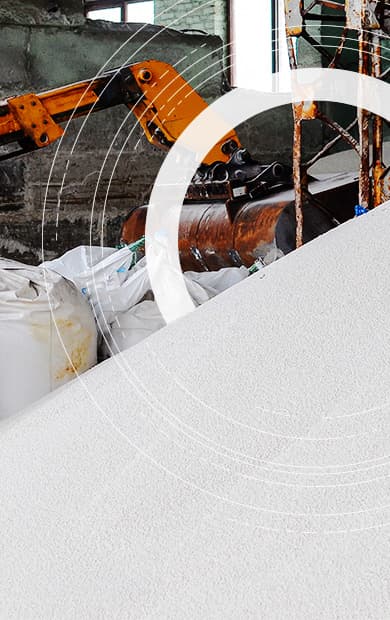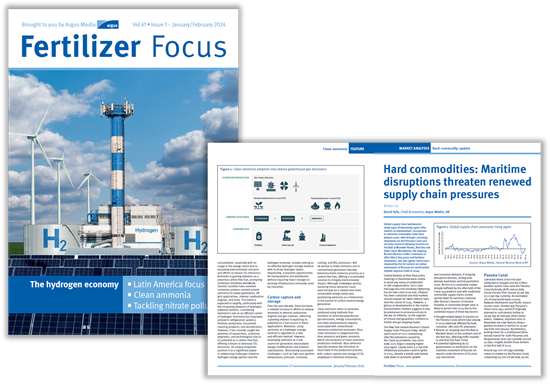

Nitrogen
Overview
The ease of urea availability east and west of Suez has shaped the current trade flows of this key nitrogen fertilizer. Despite challenges posed by energy prices and military conflicts, key import markets such as India, Australia, and Latin America remain robust. But structural oversupply and the role of China as a swing exporter have led to price volatility as this fast-moving market seeks equilibrium, more so during seasonally high-demand periods.
Our extensive nitrogen coverage includes prilled and granular urea, UAN, ammonium nitrate, and ammonium sulphate. Argus has many decades of experience covering the nitrogen market and incorporates our multi-commodity market expertise in key areas including ammonia and natural gas to provide the full market narrative.
Argus support market participants with:
- Daily and weekly nitrogen price assessments, proprietary data and market commentary
- Short and medium to long-term forecasting, modelling and analysis of urea prices, supply, demand, trade and projects
- Bespoke consulting project support
Latest nitrogen news
Browse the latest market moving news on the global nitrogen industry.
Argentina to remove import duties on urea, UAN: Caputo
Argentina to remove import duties on urea, UAN: Caputo
Amsterdam, 10 April (Argus) — Argentina's economic minister Luis Caputo is proposing to eliminate import tariffs of 5.4pc and 3.6pc on nitrogen-based fertilizers urea and UAN. Caputo reported the planned move on X, formally known as Twitter, without specifying a timeline. Argentina is the third-largest urea import market in Latin America, after Brazil and Mexico, receiving 825,000t last year, and as much as 1.55mn t in 2021, trade data show. Egyptian product accounted for 44pc of imports, or 364,000t, in 2023. Argentina has a commercial agreement with Egypt which exempts the import duty. Meanwhile, Nigerian producers supplied almost a fifth at 156,000t, while imports of Algerian urea were 125,000t last year. The country has one major urea producer, Profertil, which is jointly owned by north America's Nutrien and Argentinian state-owned energy company YPF, and has an annual granular urea capacity of 1.32mn t. UAN receipts were around 350,000 last year, down from just over 680,000t in 2020. Imports are typically sourced from the US, Trinidad and Tobago and Russia. By Harry Minihan Send comments and request more information at feedback@argusmedia.com Copyright © 2024. Argus Media group . All rights reserved.
India’s urea stocks climb by 17pc in March
India’s urea stocks climb by 17pc in March
Amsterdam, 4 April (Argus) — Indian urea inventories rose to around 8.8mn t by the end of last month, up by 17pc from 7.5mn t at the end of February, as output and imports rose to offset stable sales. Production hit 2.49mn t last month, up from 2.38mn t a year earlier, provisional official data show. It also marks a rise from 2.33mn t in February, which typically sees lower levels during the turnaround season. Sales in March were largely stable from a year earlier at 1.57mn t. The rise in production combined with imports of 375,000t to push urea stocks up to around 8.8mn t, having started March at 7.5mn t (see chart) . And inventories are set to receive further support in the coming months with importer and supplier Rashtriya Chemicals and Fertilizers' (RCF) conclusion of its 27 March tender , buying 724,000t of urea for shipment from load ports up to 20 May. Indian urea production surges in 2023-24 The higher output lifted total fertilizer production to 31.3mn t between April 2023 and March 2024, up by 9.8pc from 28.5mn t in the 2022-23 fertilizer year. The rise in domestic production can be largely attributed to supplier Hindustan Urvarak and Rasayan (Hurl), which tripled urea output in 2023-24 to 3.55mn t, as it ramped up production at its three sites. Hurl produced 1.21mn t of urea in the 2022-23 fertilizer year, according to its last annual report. Fellow producer Matix has also increased output at its 1.3mn t/yr Panagarh plant since early 2022. Cumulative urea sales across the country were 35.8mn t in 2023-24, up slightly from 35.7mn t. Inventories climbed by a net 2.6mn t in 2023-24, marking the highest in recent years and dwarfing an increase of 405,000t in 2022-23, largely driven by the rise in domestic output. By Harry Minihan India's monthly net change in urea stocks (mn t) Send comments and request more information at feedback@argusmedia.com Copyright © 2024. Argus Media group . All rights reserved.
Bridge collapse disrupts Baltimore UAN imports
Bridge collapse disrupts Baltimore UAN imports
Houston, 27 March (Argus) — UAN distributors near Baltimore, Maryland, are holding off from issuing new offers until it becomes clearer when the port there will reopen following its closure from a major bridge collapse. There is limited spot availability for UAN in Baltimore, market participants told Argus . At least one UAN vessel was due to arrive in Baltimore in April. Vessels delivering to Baltimore could be diverted elsewhere, possibly to ports like Chesapeake, Virginia, Philadelphia, Pennsylvania, or Wilmington, North Carolina. The east coast terminal UAN price — encompassing the US eastern seaboard — has risen by 13pc since the beginning of the year because of seasonal demand to $300/st fot on 29 February, where the price has held since. When offers for UAN in Baltimore do re-surface they will likely do so at higher levels because of restricted supply to the port. By Calder Jett Send comments and request more information at feedback@argusmedia.com Copyright © 2024. Argus Media group . All rights reserved.
Yara curtails 2023 European ammonia production by 19pc
Yara curtails 2023 European ammonia production by 19pc
London, 25 March (Argus) — Europe's largest fertiliser producer Yara operated its European ammonia plants at nearly a fifth below their capacity last year, despite its weighted-average gas costs more than halving compared with 2022. Yara curtailed 19pc — or 890,000t — of its ammonia production capacity last year, while it curbed its finished fertiliser production capacity by 15pc, it said in its annual report released last week. This was distinctly below ammonia curtailments of 35pc in 2022 , when the firm insisted it "will not produce or sell at negative margins". Yara's European plants have an average efficiency rate of roughly 36mn Btu per tonne of ammonia produced, according to Argus Consulting estimates, which implies that 890,000t of lost ammonia production is equivalent to about 786mn m³ of gas demand. That said, the firm prioritised production at its most efficient plants such as Sluiskil in the Netherlands and Brunsbuttel in Germany, from which it exported to its less efficient sites where production ran at lower rates. Yara curtailed nearly a fifth of its ammonia capacity, despite its European weighted-average gas cost more than halving to $14.90/mn Btu from $31.80/mn Btu in 2022. Prices were still much higher than in previous years — they were lowest at just $3.60/mn Btu in 2020 ( see prices graph ). Yara's global ammonia production edged down to 6.39mn t in 2023, from 6.51mn t in 2022. And it stayed well below a 2019 peak of 8.48mn t in 2019, suggesting the firm has moved more towards imports to bolster its own production, rather than prioritising strong run rates at its facilities. Yara operates in a "world of volatility" because of military conflicts in Ukraine and the Middle East, which affect global supply chains, the firm said. "Strengthened operational flexibility" remains a priority in this context, it said. The firm has warned repeatedly of geopolitical risks associated with an influx of Russian fertiliser output fed by gas that is much cheaper than in Europe. "Vladimir Putin is using fertilisers as a weapon of war," Yara said. "We're sleepwalking into repeating the same mistake with fertilisers as we did with Russian energy imports," Yara's chief executive Svein Tore Holsether told Argus in February . But Yara expects higher European production in 2024, as gas prices have continued to come down while fertilisers prices have held firm. Assuming stable gas purchases, gas costs in the first and second quarters could be $320mn and $100mn lower, respectively, than in the same period last year, Yara said in February . The firm suggested its European ammonia assets could run at or above 90pc of capacity. In regions with "efficient gas markets", Yara seeks exposure to spot market prices "unless exceptional market circumstances clearly give reason for deviation", it said. But in regions without such "efficient" gas markets, the firm prefers entering longer-term contracts "if favourable gas prices are obtainable". Yara has a "high" risk appetite for exposure to gas prices because securing access to, and stable supply of, favourably-priced gas is "imperative to our operations and competitiveness", the firm said. "All of our European gas contracts are hub-based, and we are well positioned to cover the risk of spot exposure," Yara said. At the same time, up to 70pc of its European plants can operate on imported ammonia. Yara's largest gas suppliers are Engie, Shell, Equinor, India's Gail, and Trinidad and Tobago's national gas company, it said. The firm consumed just under 6bn m³ globally in 2023, down from a peak of 6.87bn m³ in 2019 ( see gas consumption graph ). By Brendan A'Hearn Yara weighted-average gas costs $/mn Btu Yara global gas consumption bn m³ Send comments and request more information at feedback@argusmedia.com Copyright © 2024. Argus Media group . All rights reserved.

Fertilizer Focus Magazine – sign up here
Get complimentary access to Argus Fertilizer Focus, our bi-monthly magazine focused on traditional fertilizer commodities and specialty fertilizers. Each issue delivers a great blend of news, features, interviews and unique insights into all aspects of the fertilizer industry.
Sign up hereSpotlight content
Browse the latest thought leadership produced by our global team of experts.
A History of Fertilizers, Oct 2023
Hear Argus’ intriguing review of the history of the fertilizer industry, from early civilization through to the late 1800s.
Insight paperNitrogen output slashed in Europe - key drivers and consequences
In this concise nitrogen market paper, Argus assess key drivers and consequences of the reduction in European nitrogen output.
PodcastMixed trend for nitrogen-based fertilizers in Southern Cone
Nitrogen fertilizer market activity is poised to continue reduced in Argentina, where farmers may switch corn acreage to soybeans, as soybeans' cost of production is lower than corn.
Explore our nitrogen products
Argus Urea Analytics
Medium to long-term analysis and outlook for the urea market, covering prices, supply, demand, costs, trade and projects.
ProductsArgus Monthly Urea Outlook
Short-term price forecasts, forward trade balances, supply-demand drivers and essential proprietary datasets.
ProductsArgus AdBlue® and DEF
Weekly prices, key market developments, real-time news and fundamentals analysis on supply and demand trends for Europe and North America.
ProductsArgus AdBlue-DEF and TGU Analytics
Analysis and outlook for the AdBlue, DEF and Technical Grade Urea markets, covering prices, supply, demand, costs, trade and market drivers.
Key price assessments
Argus prices are recognised by the market as trusted and reliable indicators of the real market value. Explore some of our most widely used and relevant price assessments.
Latest events


